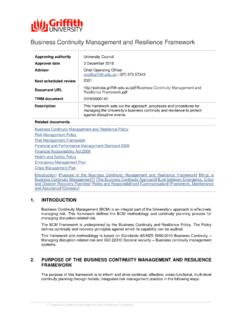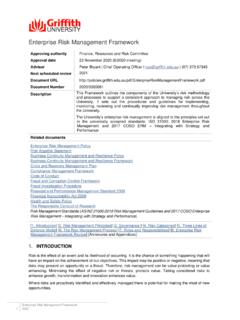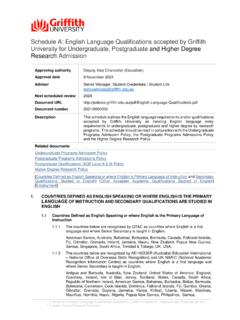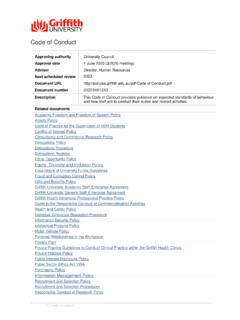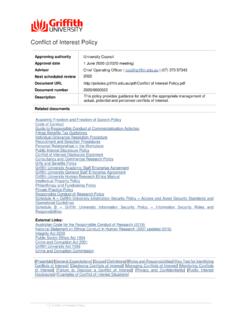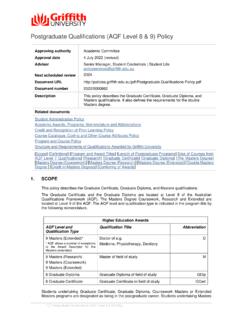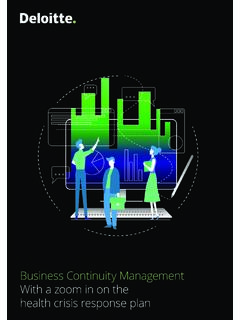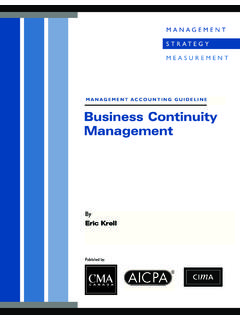Transcription of Business Continuity Management and Resilience Policy
1 1 Business Continuity Management and Resilience Policy Business Continuity Management and Resilience Policy Approving authority University Council Approval date 3 December 2018 Advisor Chief Operating Officer | | (07) 373 57343 Next scheduled review 2021 Document URL Continuity Management and Resilience TRIM document 2018/0000120 Description Griffith University must be assured of its continued viability before, during, and after a disruptive event. This Policy provides the foundation for improving Business Continuity Management (BCM), an important element of a Resilience philosophy which supports the University vision to be one of the most influential universities in Australia and the Asia-Pacific region . Related documents Risk Management Policy Risk Management Framework Business Continuity Management and Resilience Framework Financial and Performance Management Standard 2009 Financial Accountability Act 2009 Health and Safety Policy Emergency Management Plan crisis Management Plan [Definitions] [Preamble] [ Policy Objectives] [ Policy Principles] [Responsibilities] 1.
2 DEFINITIONS a) Business Continuity (BC) - A state of continued, uninterrupted operation of a Business . It focuses on the resiliency of people, property, processes, platforms and providers as well as the availability and integrity of information. b) Disruption-related risk refers to an outage which has a time and Business impact dimension, and how quickly or severely the outage could affect achievement of University time-sensitive objectives. c) Business Continuity Management (BCM) a holistic process that identifies potential threats to an organisation and the impacts to Business operations that those threats, if realised, might cause. It provides a framework for building organisational Resilience with the capability for an effective response that safeguards the interests of key stakeholders, reputation, brand and value-creating activities. (ISO 22310) BCM is an integral part of the University s enterprise risk Management effort to manage disruption- related risk and respond to emergencies.
3 2 Business Continuity Management and Resilience Policy d) Business Continuity Plan (BCP) An output of BCM. This process leads to a clearly defined and documented plan which sets out the processes, resources, systems and information necessary to continue or restore the activities of an organisation should unpredicted Business disruption occur. e) Resilience An organisation s ability to achieve its immediate objectives in uncertain and non-routine times. The national perspective is, organisations need to be resilient, they need to be able to absorb an event that necessitates change, to adapt and continue to maintain their competitive edge and profitability. (Valastro, J. Co-Chair Resilience Expert Advisory Group). 2. PREAMBLE BCM is an important element in the University s enterprise approach to risk Management , which is integral to corporate governance.
4 It deals specifically with disruption-related risk and is a critical discipline for building operational Resilience capability. This Policy ensures a consistent approach to BCM is adopted across the University. This Policy reinforces the University s Risk Management Policy and was developed with reference to HB 292-2006 A Practitioners Guide to Business Continuity Management , Standards Australia AS/NZS 5050:2010 Business Continuity Managing disruption-related risk, and International Standard ISO 22301 Societal security Business Continuity Management systems Requirements. This Policy underpins the Business Continuity Management and Resilience Framework and should be read in conjunction with the Framework. 3. Policy OBJECTIVES This Policy aims to ensure Continuity of education, research, commercial viability and reputation where the University experiences interruption to, or loss of access to its critical components of people, physical assets, resources, information and communication systems, vital records, logistics or a combination of all.
5 Specific objectives are: (a) Define the principles which will underpin enterprise BCM (b) Establish scope of Business operations for which a viable Continuity and recovery capability will be developed (c) Assign key BC responsibilities (d) Fulfil regulatory requirements 4. Policy PRINCIPLES Continuity , recovery and Resilience are realised only through the sustained, collective actions of staff who must respond to, manage, recover from, and restore the University s capabilities when disruptive events threaten to stop service delivery and damage the University s operations. The following principles provide a common set of expectations: (a) Holistic: Applies to all relevant University officers and staff. The Policy extends to all current and future activities, and new opportunities. (b) Sponsored: University Council and Executive Group are collectively accountable for the University s Business Continuity , recoverability and Resilience .
6 (c) Overall Approach: The University will take a key risks approach to BCM. 3 Business Continuity Management and Resilience Policy (d) Communicated: Seamless vertical and horizontal communications consisting of common terminology and clearly defined goals are critical for BCM initiatives to succeed. Regular, timely communications targeted to provide University officers and staff the right information at the right time and to solicit their input and feedback will be implemented to reinforce the University s BC message. (e) Integrated: Relevant managers are responsible for making BC an integral element of their sphere of influence, for making appropriate risk mitigation decisions and contributing to the University Resilience philosophy. (f) Assigned: BC Plan development, maintenance and exercises are senior managers responsibility. The Manager, Risk and Business Continuity will assist to provide the tools to help identify, manage and monitor risks and prepare staff, as appropriate.
7 (g) Impact Driven: BC plans will reflect recovery objectives appropriate to the characteristics, risk profile and priority to University mission. (h) Ongoing: BCM will be executed as a continuous process across the University. 5. RESPONSIBILITIES University Council oversees BCM as a component of risk Management within the University, on advice from the Finance, Resources and Risk Committee. The Chief Operating Officer is responsible for coordinating the implementation of BCM within the University. The Director, Audit, Risk and Compliance together with the Manager, Risk and Business Continuity will implement and maintain a BCM framework, including programme and tools, to provide for the continued availability of critical Business processes and resources under the authority of the Chief Operating Officer. The Executive Group, with guidance from the Director, Audit, Risk and Compliance and the Manager, Risk and Business Continuity , is responsible for implementing BCM within their portfolio areas.
8
